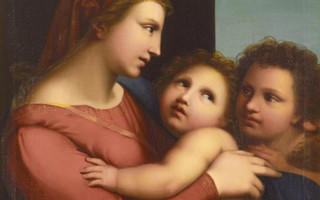
The First Jewish Painter
Moritz Daniel Oppenheim, who lived in Frankfurt, was the first Jewish painter of the modern era. The range of his work is impressive and spans religious, literary, and historical themes as well as allegories and portraits. He became world-famous with his "Scenes from Traditional Jewish Family Life".
Oppenheim was born and remained Jewish. In contrast to most Jewish artists of his generation, he did not convert to Christianity. In his paintings, he accompanied and commented on the emancipation process of German Jews and their struggle for equal rights, which was not concluded until the founding of the German Empire in 1871.

Oppenheim was the first Jewish painter in Germany to receive academic training. He studied art in his home town of Hanau, and later in Munich and Paris. Copying the works of old masters was part of his studies at the academy. Upon closer inspection, even the copies he made as a student revealed Oppenheim’s undeniably Jewish perspective. In copying Raphael’s Madonna della Tenda (Madonna of the Veil), just recently acquired by Munich’s Alte Pinakothek, the then 19-year-old Oppenheim simply omitted the details that seemed too distinctly Christian to him. Oppenheim’s painting, for example, does not depict young John the Baptist’s cross staff or the halos that appear above the figures’ heads in the original painting.
Portraitist of the Jewish Bourgeoisie
An urban Jewish middle class established itself in Frankfurt in the aftermath of the Napoleonic wars. Many restrictions from the ghetto period were removed and Jews began to play an important economic role. Oppenheim made a name for himself as a portraitist of a self-confident middle class that was nonetheless still subject to legal and social discrimination.
Oppenheim’s portraits were not only "private" paintings; they also shaped the public image of the Jewish middle class, starting with the Rothschild banking family and extending to intellectuals such as Heinrich Heine and Ludwig Börne, as well as the philologist Jakob Weil. These paintings present middle-class virtues, like restraint and respectability, but also often emphasize values such as education and culture.
Joseph Wertheimer, Jüdische Kunst, jüdische Künstler und jüdische Kunstfreunde, 1858"He had the idea of depicting Jewish themes with Jewish consciousness – not only addressing them but also systematically incorporating them into an entire series of successful works that became known to a broader public largely through engravings and lithographs."
Scenes from Traditional Jewish Family Life

Oppenheim’s "Scenes from Traditional Jewish Family Life" may also be interpreted as a statement on German Jews’ cultural affiliation. Bourgeois values bordering on cliché, such as piety, sense of family, education and respectability, are brought to the fore through historical genre painting, emphasizing an alignment with the Christian bourgeoisie’s guiding principles. This contrasts later with Orientalism, which focused on the exotic. These paintings enabled the majority population to identify with the foreign traditions and customs of Jews. The series was systematically reproduced in different techniques, thus very deliberately intended for a mass audience.
Moritz Daniel Oppenheim’s Paintings
Approximately one third of the almost 350 of Oppenheim’s documented paintings are considered lost. Many of them found their way to other countries after 1933 in the baggage of Jews emigrating. As a result, today some of the most important pieces by Oppenheim are to be found in the collections of the Jewish Museum New York and the Israel Museum in Jerusalem.
The Museum Schloss Philippsruhe in Oppenheim‘s home town of Hanau and the Jewish Museum Frankfurt have also built up extensive collections of his works over the last few decades. We have two rooms in our new permanent exhibition dedicated to Oppenheim’s paintings from different creative periods in his life.